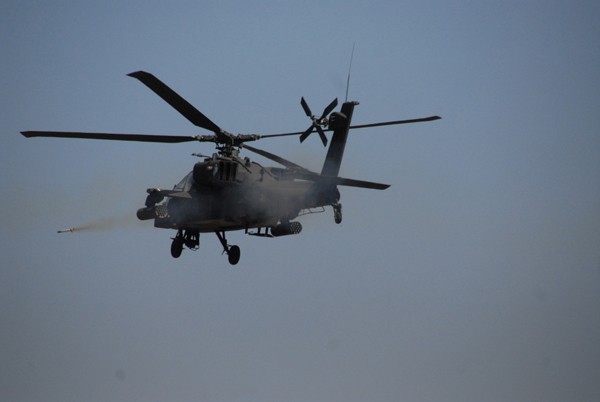RODRIGUEZ RANGE - Armor crewmen, gunners, infantrymen, artillerymen and Soldiers wearing the 2nd Infantry Division Indianhead patch made history with Republic of Korea Army soldiers as they participated in a Combined Live Fire Exercise April 15 on Rodriguez Range.
Since the beginning of the Korean War in June 25, 1950 U.S. and ROK Soldiers have worked together with each other, but the CALFEX marks the first time in 60 years both countries used such a large number of Soldiers, equipment and weaponry in a military training exercise.
As tears rolled down the eyes of retired Gen. Paik Sun-yup, the first four star general in the Korean Army and one of the last living veterans that fought in the Korean War, he turned to Maj. Gen. Michael S. Tucker, 2ID commander, during the live fire and said "I think I am back in 1950 watching the U.S. and ROK Soldiers," just as Paik did 60 years ago.
Tucker told both U.S. and ROK Army Soldiers participating in the exercise how proud he was of their efforts training for the past four months as a combined unit and successfully completing the exercise.
"There may have been crazy things going on at your level as there always is because there is friction, but from the base of the tower it looked like a beautiful orchestra out there," Tucker said.
While most Soldiers and Families were welcoming the New Year with resolutions, Soldiers from the 1st Heavy Brigade Combat Team, 2-9 Infantry Battalion, 75th Mechanized Infantry Brigade (ROKA), 27th Armor Battalion (ROKA), 125th Mechanized Infantry Battalion (ROKA) and other supporting units from Warrior Country as well as Humphreys Garrison have been training for the exercise in early January.
Warriors welcomed their Korean counterparts on post and started to go through small tasks and drills in small squads ensuring that all Soldiers understood their specific role in the exercise.
"Since January these Soldiers first came together and began living together, training together, eating together," Tucker said. "Every week they worked as a team in a crawl, walk, run type scenario to get to this graduation exercise."
"The purpose of today's exercise is to demonstrate the alliance that we have between U.S. and ROK. These Soldiers have been training together and this is an example of how we together work as an alliance to achieve our military objectives," he said.
"This is a great accomplishment, I hope events like this continue on and don't stop here," said Staff Sgt. Chad Walker, D Company 2-9 armor crewman. "Exercises like this bring both countries together which is great for morale; our platoon, in particular, trained the ROK Soldiers; we went out on the range together and pretty much have been working with them the entire time we have been out here which brought us very close to each other."
On the final day, members from the chain of command of the primary and supporting units were invited to see the live fire exercise. Kim, Moon-soo, Gyeonggi province governor, congressmen, county commissioners, and retired U.S. and ROK Army Soldiers were also in attendance for the CALFEX.
A static display of every piece of equipment that would be used in the live fire portion of the CALFEX including the vehicles, helicopters and weapons being fired was set up for all in attendance to see.
Soldiers stood by and explained the functions and capabilities of their equipment and answered all of the questions that were asked of them about the live fire.
"What you will see today is what makes being stationed here and living in Korea so exciting for the U.S. military," said Gen. Walter L. Sharp, United States Forces Korea commander. "You will be able to see today a total combined arms attack where we have all of the different engineers, artillery, armor, infantry and a joint perspective with aviation with fast movers in the Air Force and we do it both on the ROK and the U.S. side fighting side by side just as we would do it had we been at war."
"The mechanics of what Soldiers do, the command and control it takes, and the battle drills it takes to execute these types of tasks are very complicated, and it takes a lot of training," Tucker said.
Once everyone found a seat and grabbed a pair of earplugs, artillery rounds hit the Pulmu mountain. Though the audience could not see the artillery rounds, the pounding sound and the thick air of brown smoke provided a spot to let the audience know the 2ID Soldiers gave indirect support for the ROK Army AH-1 Cobras and U.S. Army AH-64 Apache attack helicopters to fire their missiles.
During the next 40 minutes the combined forces with air support from the U.S. Air Force continued to attack Pulmu mountain.
After the last tank platoon engaged the enemy with all available weapons, team Demon completed their mission for the CALFEX.


Social Sharing